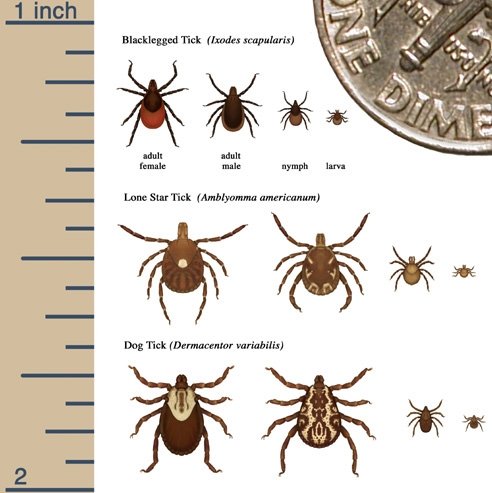Tricky Ticks
Ticks can be carriers of serious diseases so prevention is important.

Did you know there are 15 types of ticks found in Illinois? They can be carriers of several serious diseases, including Lyme Disease. Prevention is important, especially during the warmer months when they are most active.
Prevention
Ticks are unable to jump or drop. They climb to the tips of weed, leaves, or grass and wait for a host (such as you or a pet) to brush against them, and then stretch out their longest legs to grab hold. Therefore, it is important to keep your skin covered and tuck pants into socks or boots before going outdoors. You should also apply permethrin to clothing and treat skin with DEET (follow instructions on label). When possible, walk in the center of a trail and avoid the underbrush. After you get home, be sure to shower off the DEET and do a thorough tick check on yourself, children, and pets. Look for any new bumps or what may appear to be moles. Most embedded ticks will look like a flattened apple seed. Pay special attention to areas with hair, behind the ears, head and neck, armpits, waist, and groin.
How to remove
Ticks should be removed as soon as possible, since the longer they feed, the more likely they are to transmit diseases they may be carrying. DO NOT use petroleum jelly (Vaseline), nail polish, turpentine, or alcohol or burn them with a match. Those techniques can cause the tick to “vomit” its disease carrying secretions into your skin. Instead, wear gloves and grasp the tick firmly with tweezers. Align the tweezers as close to the skin as possible and pull away gently and steadily. Avoid twisting since the jaw parts can be broken off and cause infection. Finish by washing the area thoroughly with soap and water and applying antiseptic to the bite. Dispose of the tick by flushing it down a toilet or wrapping it in tape.
Symptoms of tick-borne illnesses
If the tick has already fed and dropped off, the bite will often have a small black dot surrounded by a red bump with a hardened center. Be sure to watch the area closely for at least two weeks for a ring-like red rash or skin sores. Other symptoms of tick-borne illnesses may include fever, chills, headache, joint or muscle aches, nausea, vomiting, diarrhea, fatigue, swollen lymph nodes, eye infections, sore throat, dry cough, chest pain, or shortness of breath.
If you have any concerns after an encounter, be sure to contact a healthcare provider as soon as possible. In the meantime, do your best to prevent tick bites so that you can get outside and enjoy a happy summer!
The following chart compares sizes and colors of the Blacklegged tick, Lone Star tick, and Dog tick (three of the most common Illinois ticks).

Susan Dibblee, PA-C, Physician Assistant, Family Medicine Clinic



